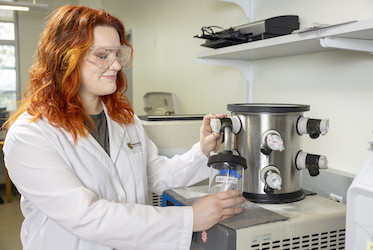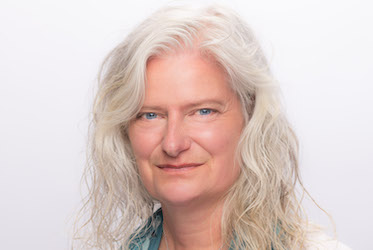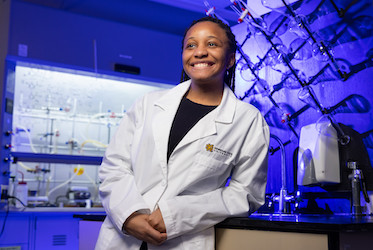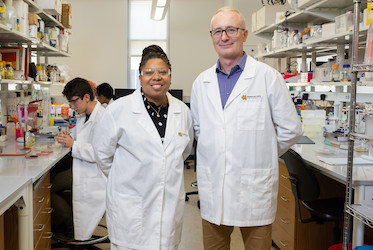
Patient Research
KENNESAW, Ga. | Dec 4, 2018
Student’s meticulous work could help treat diseases
|
|
|
|---|---|
|
|
|
|
|
Each year, thousands of undergraduates from all over the United States participate in the National Conference on Undergraduate Research (NCUR). NCUR, the largest conference dedicated to undergraduate research in the country, features work from some of the nation’s best and brightest students. Kennesaw State, which will serve as the host institution for NCUR 2019 April 11-13, had nearly 100 students present at this year’s conference at the University of Central Oklahoma campus in Edmond. Steven Ho of Kennesaw is one of many KSU students who have presented at NCUR. |
Steven Ho, a senior biology major, is conducting cell research that could assist in the treatment of cancer and other diseases. The goal of the research, led by professor of chemistry Jonathan McMurry and his postdoctoral associate Julia LeCher, is to develop protein-based therapeutics and novel delivery platforms for the treatment of disease.
Most diseases are the result of mutated, damaged or missing genes, and replacing a damaged gene is very difficult. Ho and his fellow researchers are going directly to the end product and replacing the protein, using protein delivery to develop therapeutics and better understand the molecular mechanisms of disease-related genes and other cellular processes.
Ho, who plans to graduate in July, participated in NCUR for the first time this year and will present again at the 2019 conference.

What is your research area?
I research molecular and cellular biology with professors Dr. Jonathan McMurry and Dr. Julia LeCher. I presented at the 2018 NCUR on how APE-1, a multi-functional protein, could be relocated throughout different parts of the cell under certain conditions using a novel cell-penetrating peptide that was developed in the lab I work in. The basis for our lab’s research and this project was to use these cell-penetrating peptides (CPPs) as a cellular delivery mechanism. As we often say in my lab, “Without using the train’s engine to pull the caboose, we can’t drop off the cargo that it carries.” Our CPPs act as the engine that allows APE-1 to be pulled into the cell where it then detaches from the engine. When APE-1 goes to the nucleus, it keeps its usual functions such as DNA repair. But when we get it into cancer cells, APE-1 stays in the cytosol, the liquid found inside cells. This is a common, though poorly understood, phenomena in carcinomas. We currently are working on a method to track movement of our protein throughout the cell in real-time under different disease-like states. This research will help shed light on how APE-1’s change in cellular location relates to diseases such as cancer.
What (and/or who) has been your inspiration for your research?
My older sister was the first in our family to graduate college after my parents immigrated to the United States. While she was at KSU, she did research with (associate professor of biology) Dr. Thomas McElroy. The first time I ever really saw anything about her research was when she presented at the College of Science and Mathematics’ annual Fall Research Symposium. I remember looking around at the other students and thinking how it was so amazing that other people my age were working on projects that no one else ever had done before. They were exploring new territories in their fields. Now, my sister is attending pharmacy school so she can go into research and create new therapeutic drugs that are more effective and safer for to use.
What motivated you to get involved with undergraduate research and NCUR?
I can credit my passion for research to my best friend and fellow biology major, David Axford. When I first came to Kennesaw State University, I didn’t have any plans to involve myself in research, let alone knew what it really involved. David exposed me to the research field where I met my amazing lab mates, Emma Parks and Luke Dickson. Being able to perform experiments side by side with the three of them under the guidance of Dr. McMurry and Dr. LeCher motivated me to work hard.

What have you gained from your experience with NCUR?
At this year’s NCUR, I gained a lot of interest in other fields. I went to every session I could and saw a variety of fields that I generally don’t pay attention to while I’m at school. I went to a session where Megan, a researcher from Montana State, talked about her ecology research in pikas (small mammals that are closely related to rabbits and hares) and realized that they sound as cute as they look. I met Spencer, also from Montana State, who studied engineering technology using ceramic microfibers. As a student representative assisting in the planning of the 2019 conference, I am twice as excited as I was last year since I still can discover new things and be able to represent KSU on a higher standard.
What advice would you give to others about doing undergraduate research or participating in NCUR?
Doing research is a blessing if you can get into it. It can open up a lot of opportunities and, while you think that you have to produce the best results every day you come in, it might not always be like that. There are days that nothing goes your way and nothing gets accomplished. My best advice is to take it slow. Not every experiment works on every trial. When something blew up in my face (figuratively) from all the mistakes I made, I often thought that I was never doing enough work to produce enough results and I ended up overworking to try and do something right. When you work a part-time job, take a full class load, and have other extracurricular commitments, it’s important to assess what your goals are and what you need to do to meet them. As the old adage says, slow and steady wins the race.
– Paul Floeckher
Photos by Lauren Kress
Related Stories
A leader in innovative teaching and learning, Kennesaw State University offers undergraduate, graduate and doctoral degrees to its more than 45,000 students. Kennesaw State is a member of the University System of Georgia with 11 academic colleges. The university’s vibrant campus culture, diverse population, strong global ties and entrepreneurial spirit draw students from throughout the country and the world. Kennesaw State is a Carnegie-designated doctoral research institution (R2), placing it among an elite group of only 7 percent of U.S. colleges and universities with an R1 or R2 status. For more information, visit kennesaw.edu.



















